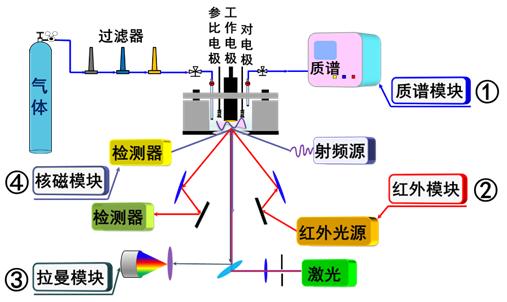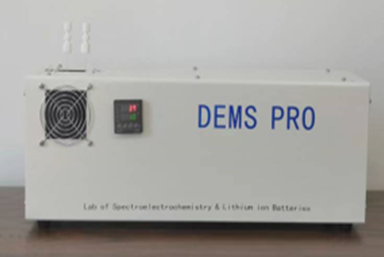About us
The Laboratory of Advance Spectro-electrochemistry and Li-ion Batteries (DNL0307) of the Dalian Institute of Chemical Physics, Chinese Academy of Sciences was established in July 2020 and is affiliated to the Divsion of Fuel Cell and Battery (DNL03), formerly known as the State Key Laboratory of Electroanalytical Chemistry, Changchun Institute of Applied Chemistry, Chinese Academy of Sciences. The group leader is Peng Zhangquan, who is supported by the National Science Fund for Distinguished Young Scholars.
The Laboratory of Advance Spectro-electrochemistry and Li-ion Batteries is oriented towards the storage and conversion technology of high-performance electrochemical energy, based on basic electrochemistry and advanced spectro-electrochemical research methods. Through the independent creation and acquisition of hardware (such as nuclear magnetic resonance radio frequency probes, etc.), development and application of spectral methods and data processing strategies, etc., and the development of electrochemistry-spectroscopy methods (such as advanced in-situ electrochemical and online NMR, MS, Raman and IR, we realize the multi-angle and multi-dimensional analysis of the complex reaction that take place in the bulk and interface of the electrochemical process. Based on the quantitative and qualitative understanding of the complex electrochemical reaction process system, we develop innovative electrochemical energy storage systems and high-performance energy materials, positively design electrode materials, electrolyte solvents, conductive lithium salts, etc. suitable for high-energy battery systems, and construct an electrochemical energy storage system with excellent electrochemical performance (high specific capacity, high rate charge-discharge, long cycle life).
中科院大连化学物理研究所谱学电化学与锂离子电池研究组(DNL0307组)成立于2020年7月,隶属于燃料电池研究部(DNL03研究部),前身为中国科学院长春应用化学研究所电分析化学国家重点实验室能源材料界面电化学研究组。组长为彭章泉研究员,获国家杰出青年科学基金支持。
谱学电化学与锂离子电池研究组面向高性能电化学能量存储与转换技术,立足基础电化学和先进谱学电化学研究方法,主要通过硬件(如核磁共振射频探头等)的自主创制以及采谱方法和数据处理策略等的开发与应用,发展先进的电化学原位、在线核磁共振、质谱、拉曼和红外等电化学-谱学联用方法,实现对电化学过程中体相和界面中发生的复杂反应过程的多角度和多维度解析。基于对电化学复杂反应过程的系统的定量和定性认识,发展创新性电化学储能体系和高性能能源材料,正向设计适用于高比能电池体系的电极材料、电解质溶剂、导电锂盐等,构筑具有优异电化学性能(高比容量、大倍率充放电、长循环寿命)的电化学储能体系。

Research Topic
1. In-situ Spectro-electrochemistry
In-situ Spectro-electrochemistry technology can greatly expand the application of spectroscopic analysis instruments (including: infrared spectroscopy, Raman spectroscopy, fluorescence spectroscopy, mass spectrometry, nuclear magnetic resonance, etc.), extending the result analysis to process analysis and improving characterization tools to research tools. In-situ Spectro-electrochemistry technology is an indispensable and important research method in the study of interfacial electrochemical processes. The process analysis of energy interface electrochemistry includes the chemical resolution of interface species and the spatiotemporal resolution of interface processes. A single In-situ Spectro-electrochemistry technology cannot fulfill the analysis of complex interface electrochemical process analysis. Combining the complementary advantages of various spectroscopic analysis techniques to realize the combination of various in-situ and online spectroscopic techniques, it can analyze the electrochemical process of complex interfaces in an all-round way, and greatly promote development of the research instruments for electrochemical interfaces with higher sensitivity, faster response time, better energy and mass resolution, etc.
1、现场谱学电化学
现场谱学电化学技术可极大地拓展谱学分析仪器(包含:红外光谱、拉曼光谱、荧光光谱、质谱、核磁等)的应用空间,使其从结果分析扩展到过程分析,从表征工具提升到研究手段。现场谱学电化学技术是界面电化学过程研究中不可或缺的重要研究手段。能源界面电化学的过程分析包含界面物种的化学分辨与界面过程的时空分辨,单一现场谱学电化学技术无法满足复杂界面电化学过程分析的需求。集合多种谱学分析技术的互补性优势,实现多种原位、在线谱学技术的联用,可对复杂界面电化学过程进行全方位的解析,并能极大促进针对电化学界面研究仪器的发展,如更高的灵敏度、更快的响应时间、更好的能量和质量分辨率等。

Figure 1. Schematic diagram of the spectroelectrochemical research platform
2. Electrocatalysis
Combined with a variety of advanced characterization methods such as in-site spectro-electrochemistry technology, solid-state ionic research methods, DFT computational electrochemistry, and isotope labeling methods, accurate spectroscopic identification and quantitative analysis of reaction intermediates and reaction products in electrochemical reactions at energy interfaces can be achieved, and elementary reaction steps, reaction sites, restricted factors of the electrochemical-related electrocatalytic reactions at the energy interface ane be systematically analyzed. The electrocatalytic reactions include: (I) HER, OER, ORR, CO2RR, NRR, etc. in aqueous electrolytes; (II) ORR, OER, CO2RR, NRR, etc. in organic electrolytes.
2、电催化
结合现场谱学电化学技术、固态离子学研究方法、DFT计算电化学、同位素标记手段等多种先进表征手段,对能源界面电化学反应中的反应中间体、反应产物实现精准的谱学识别与定量分析,系统解析能源界面电化学相关电催化反应的基元反应步骤、反应位点、受限因子等。电催化反应包含:(I)水系电解液中的HER、OER、ORR、CO2RR、NRR等;(II)有机系电解液中的ORR、OER、CO2RR、NRR等。


Figure 2. Spectroscopy and electrochemistry combined with theoretical calculation to study the reaction principle of oxygen electrode
3. Li-ion batteries, metal-air batteries
Based on the in-depth understanding of the energy electrochemical interface reaction principles (including elementary reaction steps, reaction sites, confinement factors, etc.), the electrode materials, electrolyte solvents and conductive lithium salts suitable for high specific energy battery systems can be positively designed. Based on designation of the original energy material , a high specific energy battery system with excellent electrochemical performance (high specific capacity, high-rate charge and discharge, long cycle life) is constructed.
3、锂离子电池,金属-空气电池
基于对能源电化学界面反应原理(包含基元反应步骤、反应位点、受限因子等)的深入理解,正向设计适用于高比能电池体系的电极材料、电解质溶剂和导电锂盐。以全新的能源材料设计为基础,构筑具有优异电化学性能(高比容量、大倍率充放电、长循环寿命)的高比能电池体系。

Figure 3. High specific energy metal-air battery
Facilities



In-situ electrochemical IR spectrometry In-situ electrochemical Raman spectrometry differential electrochemical mass
spectrometry



In-situ electrochemical NMR Magnetron sputtering Rotating Disk Electrode system